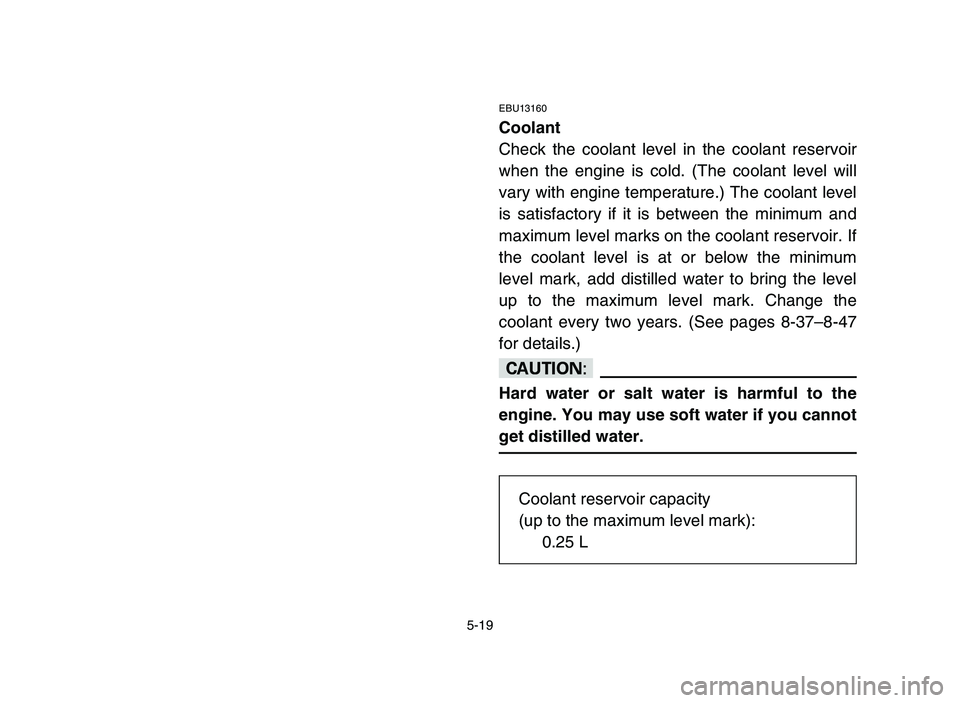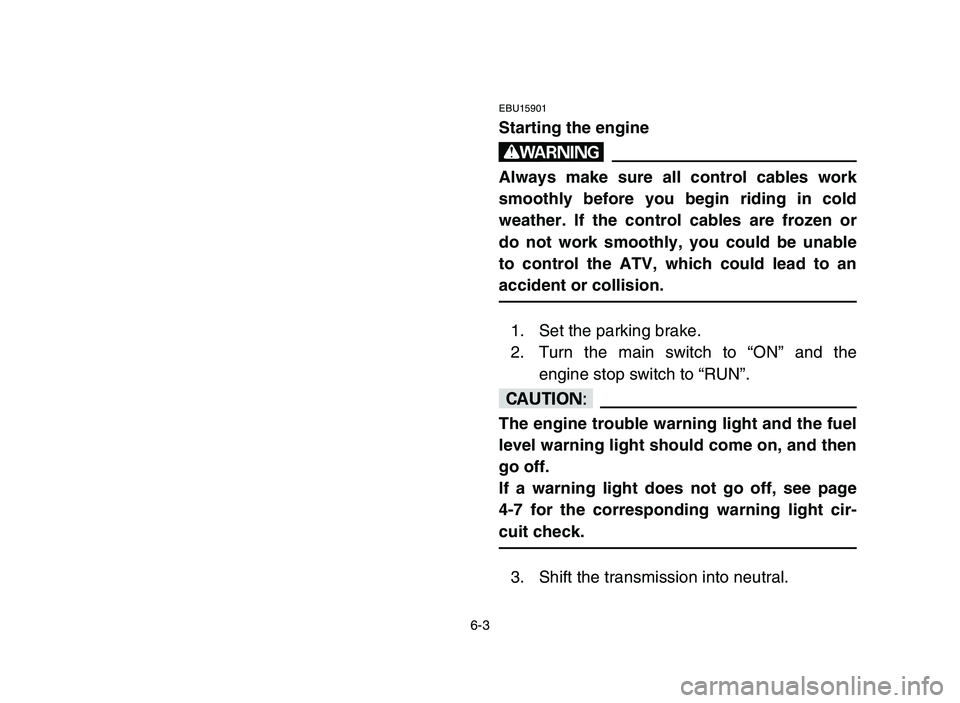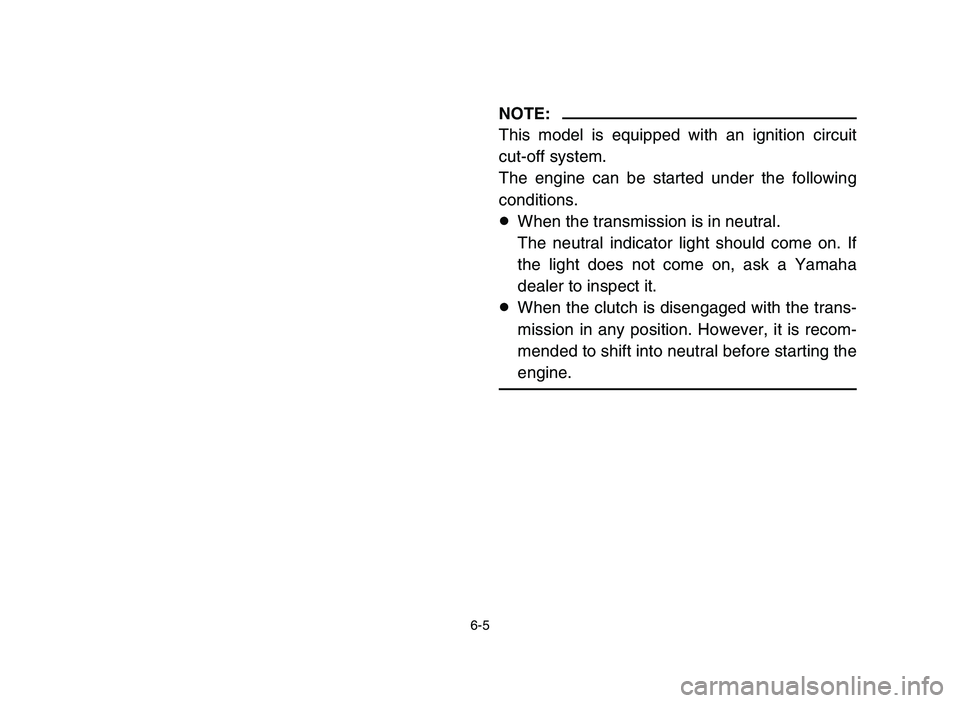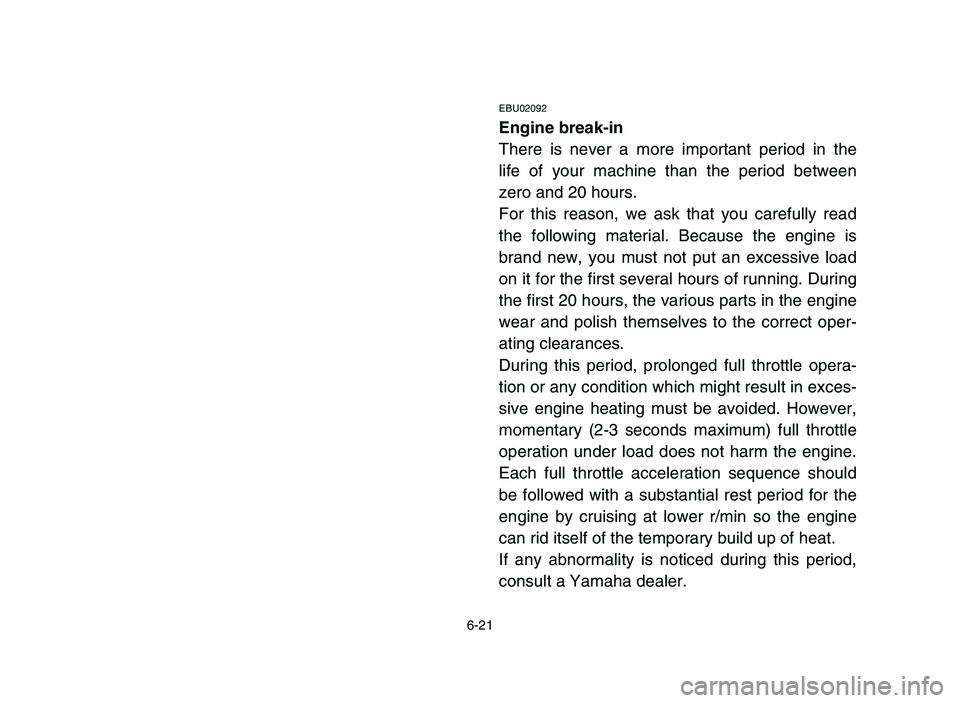engine YAMAHA YFM700R 2006 Owner's Manual
[x] Cancel search | Manufacturer: YAMAHA, Model Year: 2006, Model line: YFM700R, Model: YAMAHA YFM700R 2006Pages: 424, PDF Size: 3.86 MB
Page 116 of 424

5-17
EBU10842
Engine oil
Make sure the engine oil is at the specified level.
Add oil as necessary. (See page 8-21.)
cC
8In order to prevent clutch slippage (since
the engine oil also lubricates the clutch),
do not mix any chemical additives. Do not
use oils with a diesel specification of “CD”
or oils of a higher quality than specified. In
addition, do not use oils labeled “ENERGY
CONSERVING II” or higher.
8Make sure that no foreign material enters
the crankcase.
Recommended engine oil type and quantity:
See page 10-2.
1S3-9-60 5-6 6/7/05 10:22 AM Page 5-17
Page 118 of 424

5-19
EBU13160
Coolant
Check the coolant level in the coolant reservoir
when the engine is cold. (The coolant level will
vary with engine temperature.) The coolant level
is satisfactory if it is between the minimum and
maximum level marks on the coolant reservoir. If
the coolant level is at or below the minimum
level mark, add distilled water to bring the level
up to the maximum level mark. Change the
coolant every two years. (See pages 8-37–8-47
for details.)
cC
Hard water or salt water is harmful to the
engine. You may use soft water if you cannot
get distilled water.
Coolant reservoir capacity
(up to the maximum level mark):
0.25 L
1S3-9-60 5-6 6/7/05 10:22 AM Page 5-19
Page 120 of 424

5-21
w
Wait for the engine and radiator to cool
before removing the radiator cap. You could
be burned by hot fluid and steam blown out
under pressure. Always put a thick rag over
the cap when opening. Allow any remaining
pressure to escape before completely
removing the cap.
1S3-9-60 5-6 6/7/05 10:22 AM Page 5-21
Page 134 of 424

6-3
EBU15901
Starting the engine
w
Always make sure all control cables work
smoothly before you begin riding in cold
weather. If the control cables are frozen or
do not work smoothly, you could be unable
to control the ATV, which could lead to an
accident or collision.
1. Set the parking brake.
2. Turn the main switch to “ON” and the
engine stop switch to “RUN”.
cC
The engine trouble warning light and the fuel
level warning light should come on, and then
go off.
If a warning light does not go off, see page
4-7 for the corresponding warning light cir-
cuit check.
3. Shift the transmission into neutral.
1S3-9-60 5-6 6/7/05 10:22 AM Page 6-3
Page 136 of 424

6-5
NOTE:
This model is equipped with an ignition circuit
cut-off system.
The engine can be started under the following
conditions.
8When the transmission is in neutral.
The neutral indicator light should come on. If
the light does not come on, ask a Yamaha
dealer to inspect it.
8When the clutch is disengaged with the trans-
mission in any position. However, it is recom-
mended to shift into neutral before starting the
engine.
1S3-9-60 5-6 6/7/05 10:22 AM Page 6-5
Page 138 of 424

6-7
4. Completely close the throttle lever and
start the engine by pushing the start
switch.
NOTE:
If the engine fails to start, release the start
switch, then push it again. Pause a few seconds
before the next attempt. Each cranking should
be as short as possible to preserve battery ener-
gy. Do not crank the engine more than 10 sec-
onds on each attempt.
5. Continue warming up the engine until it
idles smoothly.
cC
See the “Engine break-in” section prior to
operating engine for the first time.
1S3-9-60 5-6 6/7/05 10:22 AM Page 6-7
Page 144 of 424

6-13
1
2 3 4 5N1R
1. Shift pedal N. Neutral position
R. Reverse position
1. Pédale de sélection N. Point mort
R. Marche arrière
1. Pedal del cambio N. Punto muerto
R. Posición de marcha atrás
EBU11730
Shifting
This model has a 5-speed forward and 1-speed
reverse transmission. The transmission allows
you to control the amount of power you have
available at a given speed or for starting, accel-
erating, climbing hills, etc. To shift into neutral,
return the throttle lever to the closed position,
apply the clutch and repeatedly depress the shift
pedal until it stops. When it stops, it will be in
first gear. Raise the pedal slightly to neutral.
cC
8Do not coast for long periods with the
engine off, and do not tow the machine a
long distance. Even in neutral position, the
transmission is only properly lubricated
when the engine is running. Inadequate
lubrication may cause damage.
8Always use the clutch when changing
gears. The engine, transmission and drive
train are not designed to withstand the
shock of forced shifting and can be dam-
aged by shifting without the clutch.
1S3-9-60 5-6 6/7/05 10:22 AM Page 6-13
Page 146 of 424

6-15
EBU02040
To start out and accelerate:
1. Release the throttle lever.
cC
Always close the throttle while shifting
gears. Otherwise, damage to the engine and
drive train may result.
2. Pull the clutch lever to disengage the
clutch.
3. Shift into first gear.
4. Open the throttle gradually and at the
same time, release the clutch lever slowly.
5. Once the machine has attained adequate
speed, release the throttle, and at the
same time, quickly pull in the clutch lever.
1S3-9-60 5-6 6/7/05 10:22 AM Page 6-15
Page 150 of 424

6-19
EBU02080
To decelerate:
When slowing down or stopping, release the
throttle and apply the brakes smoothly and
evenly. As you slow down, shift to a lower gear.
Be sure that the engine has sufficiently slowed
before engaging a lower gear. Improper use of
the brakes or shifting can cause the tires to lose
traction, reducing control and increasing the
possibility of an accident.
w
Make sure the engine has sufficiently slowed
before shifting to a lower gear. Engaging a
lower gear when the engine speed is too
high could make the wheels stop rotating.
This could cause loss of control, an accident
and injury. It could also cause engine or
drive train damage.
1S3-9-60 5-6 6/7/05 10:23 AM Page 6-19
Page 152 of 424

6-21
EBU02092
Engine break-in
There is never a more important period in the
life of your machine than the period between
zero and 20 hours.
For this reason, we ask that you carefully read
the following material. Because the engine is
brand new, you must not put an excessive load
on it for the first several hours of running. During
the first 20 hours, the various parts in the engine
wear and polish themselves to the correct oper-
ating clearances.
During this period, prolonged full throttle opera-
tion or any condition which might result in exces-
sive engine heating must be avoided. However,
momentary (2-3 seconds maximum) full throttle
operation under load does not harm the engine.
Each full throttle acceleration sequence should
be followed with a substantial rest period for the
engine by cruising at lower r/min so the engine
can rid itself of the temporary build up of heat.
If any abnormality is noticed during this period,
consult a Yamaha dealer.
1S3-9-60 5-6 6/7/05 10:23 AM Page 6-21